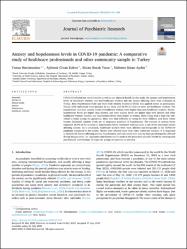| dc.contributor.author | Hacımusalar, Yunus | |
| dc.contributor.author | Kahve, Aybeniz Civan | |
| dc.contributor.author | Yaşar, Alişan Burak | |
| dc.contributor.author | Aydın, Mehmet Sinan | |
| dc.date.accessioned | 2020-10-03T16:10:32Z | |
| dc.date.available | 2020-10-03T16:10:32Z | |
| dc.date.issued | 2020 | en_US |
| dc.identifier.issn | 0022-3956 | |
| dc.identifier.issn | 1879-1379 | |
| dc.identifier.uri | https://hdl.handle.net/11363/2424 | |
| dc.description | Document Information
Language:English
Accession Number: WOS:000571186500028
PubMed ID: 32758711 | en_US |
| dc.description.abstract | COVID-19 affected our mental health as well as our physical health. In this study, the anxiety and hopelessness levels of healthcare workers and non-healthcare workers and the factors affecting them were evaluated in Turkey. Beck Hopelessness Scale and State-Trait Anxiety Inventory (STAI) was applied online to participants. Totally 2156 individuals were included in the study and 52.0% (n:1121) of them are healthcare workers. The hopelessness and state anxiety levels of healthcare workers were higher than non-healthcare workers. Nurses' hopelessness levels are higher than doctors, and state anxiety levels are higher than both doctors and other healthcare workers. Anxiety and hopelessness levels were higher in women, those living with a high-risk individual at home during the pandemic, those who had difficulty in caring for their children, and those whose income decreased. Anxiety levels are an important predictor of hopelessness. The increase in anxiety levels explained 28.9% of the increase in hopelessness levels. Increased working hours is one of the important factors affecting anxiety. As a conclusion, healthcare workers were more affected psychologically in the COVID-19 pandemic compared to the society. Nurses were affected more than other healthcare workers. It is important to identify the factors affecting anxiety, hopelessness, and individuals who may be more psychologically affected during the pandemic. An important contribution can be made to the protection of public health by ensuring that psychosocial interventions for high-risk groups are planned in advance. | en_US |
| dc.language.iso | eng | en_US |
| dc.publisher | PERGAMON-ELSEVIER SCIENCE LTD, THE BOULEVARD, LANGFORD LANE, KIDLINGTON, OXFORD OX5 1GB, ENGLAND | en_US |
| dc.relation.isversionof | 10.1016/j.jpsychires.2020.07.024 | en_US |
| dc.rights | info:eu-repo/semantics/openAccess | en_US |
| dc.rights | Attribution-NonCommercial-NoDerivs 3.0 United States | * |
| dc.rights.uri | http://creativecommons.org/licenses/by-nc-nd/3.0/us/ | * |
| dc.subject | COVID-19 | en_US |
| dc.subject | Mental health | en_US |
| dc.subject | Anxiety | en_US |
| dc.subject | Hopelessness | en_US |
| dc.subject | Healthcare workers | en_US |
| dc.subject | PSYCHOLOGICAL IMPACT | en_US |
| dc.subject | LIFE EVENTS | en_US |
| dc.subject | DEPRESSION | en_US |
| dc.subject | SARS | en_US |
| dc.subject | UNCERTAINTY | en_US |
| dc.subject | PHYSICIANS | en_US |
| dc.subject | QUARANTINE | en_US |
| dc.subject | WORKLOAD | en_US |
| dc.subject | BURNOUT | en_US |
| dc.title | Anxiety and hopelessness levels in COVID-19 pandemic: A comparative study of healthcare professionals and other community sample in Turkey | en_US |
| dc.type | article | en_US |
| dc.relation.ispartof | JOURNAL OF PSYCHIATRIC RESEARCH | en_US |
| dc.department | İktisadi İdari ve Sosyal Bilimler Fakültesi | en_US |
| dc.authorid | http://orcid.org/0000-0002-1777-2707 | en_US |
| dc.authorid | http://orcid.org/0000-0002-0683-5207 | en_US |
| dc.authorid | http://orcid.org/0000-0002-6778-3009 | en_US |
| dc.authorid | http://orcid.org/0000-0002-7218-3972 | en_US |
| dc.identifier.volume | 129 | en_US |
| dc.identifier.startpage | 181 | en_US |
| dc.identifier.endpage | 188 | en_US |
| dc.relation.publicationcategory | Makale - Uluslararası Hakemli Dergi - Kurum Öğretim Elemanı | en_US |



















